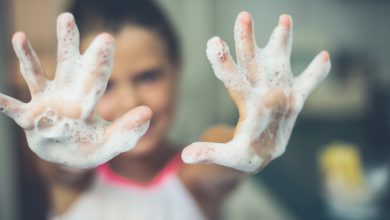Protect Your Child from Household Poisons

Protect Your Child from Household Poisons
Did you know 2 children die of poisoning every day?
Poison exposure sends 300 kids or teens to the emergency room each day, according to the Centers for Disease Control & Prevention.
And young children are at especially high risk.
Out of nearly 2.12 million incidents reported to Poison Control Centers in 2017, 45% of them involved kids under 6 years old!
How can you protect your own children? It’s all about understanding the risk, taking steps to prevent exposure and knowing what to do if a poisoning occurs.
Understand the Risk of Common Household Poisons
Over 90% of poisonings happen at home.
For example, sometimes kids ingest medications used to treat a range of conditions in older folks, such as high blood pressure, depression and pain management.
But other household products can pose a danger as well. For children under 6 years old, 57% of poisonings involve non-medicines. Here are the most common substances responsible for poison exposure in kids under 6 for 2017, according to Poison Control:
- Cosmetics and personal care products: 12.6%
- Cleaning substances: 11.0%
- Analgesics: 9.2%
- Foreign bodies, toys, etc.: 6.4%
- Topical preparations: 4.8%
- Antihistamines: 4.7%
- Vitamins: 4.3%
- Pesticides: 3.4%
- Dietary supplements: 3.4%
- Plants: 2.8%
In addition, here are the substances most responsible for poisoning fatalities in children under 6:
- Analgesics: 18.4%
- Fumes, gases or vapors: 15.7%
- Unknown drugs: 7.7%
- Batteries: 5.8%
- Antihistamines: 5.0%
- Cardiovascular drugs: 5.0%
- Stimulants and street drugs: 4.2%
- Antidepressants: 3.8%
- Alcohols: 3.5%
- Cleaning substances: 3.5%
Reduce the Risk of Poisoning in Children
Attention is the best prevention when it comes to accidental poisoning. Close adult supervision is essential for keeping inquisitive hands away from inappropriate containers or objects.
In fact, calls to Poison Control Centers peak between 4 p.m. and 10 p.m. each day — hours when grown-ups are distracted with coming home from work, preparing meals and getting ready for bed.
The CDC recommends additional measures to protect your children:
- Lock up poisons. That includes all medications as well as other household products including cosmetics, cleaning pods and substances that give off harmful fumes. Don’t display plants that could be harmful if ingested or touched.
- Read labels. Never let young children take medications unsupervised. Read the warnings and follow all directions carefully when giving medicines to your child.
- Get rid of poisons you aren’t using. Keeping expired or unused products around the house only increase the risk of accidental exposure. Find local resources for properly disposing of outdated medications, vitamins and supplements.
- Know when to call for help. Program the Poison Control number into your phone: 1-800-222-1222. In the event of poison exposure, call Poison Control if the victim is still awake and alert, and call 911 if they are unconscious or not breathing.
Know What to Do if Poisoning Occurs
Suppose you discover your child with an open or empty container of a toxic substance. What comes next?
First of all, remain calm and act quickly. The appropriate response depends on the nature of the suspected exposure.
If your child has swallowed a poisonous substance:
- Immediately remove the container away from your child’s reach.
- If the substance is in your child’s mouth, make them spit it out or remove it with your fingers, clean towel or washcloth.
- Do not induce vomiting.
- If your child is alert and unsymptomatic, call Poison Control at 1-800-222-1222.
Call 911 if your child has any of the following symptoms:
- Sore throat
- Trouble breathing
- Drowsiness or irritability
- Nausea, vomiting or stomach pain
- Burns or blisters on mouth or lips
- Unusual drooling
- Strange breath odor
- Unusual clothing stains
- Seizures
- Unconsciousness
Show the poison container to healthcare providers so they know what was ingested.
In some cases, your child may have inhaled harmful fumes or gases. Examples include car exhaust, leaky vents, smoke from wood or kerosene, household cleaners, paints or solvents.
- Get your child into fresh air right away.
- Call Poison Control if your child is breathing normally.
- Call 911 if your child has trouble breathing.
- Administer CPR and call 911 if your child stops breathing.
Finally, harmful substances may sometimes spill or get rubbed into your child’s eyes. If poison gets on your child’s skin:
- Remove clothing
- Rinse with lukewarm water for 15 minutes
- Call Poison Control
- Don’t apply ointments or grease
If poison gets into your child’s eye:
- Hold the eyelid open and flush with lukewarm water for 15 minutes.
- Call Poison Control.
- Don’t use eye drops or ointments unless instructed to do so.
By understanding the risk, emphasizing prevention and knowing what to do in an emergency, you can protect your child from the dangers of household poisoning.
At Little Sunshine’s Playhouse & Preschool®, safety is a top priority in all of our schools. Contact a location near you to learn more about how we protect your child’s safety at preschool.
Additional Blog Posts:
Enjoy the Pool with Water Safety Rules from Little Sunshine’s Playhouse®
Is It Okay for My Child to Go Online? Internet Safety for Kids
5 Essentials for Preschool Playground Safety





